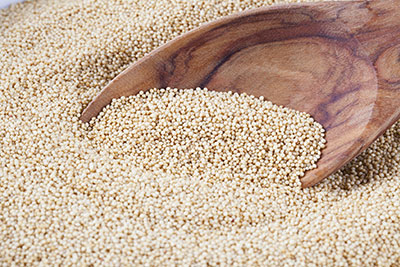
Technical Talk: August-September 2014
August 28, 2014
By John Michaelides
Increasing the protein content of your baked goods can create desirable food products
Increasing the protein content of your baked goods can create desirable food products
 |
|
| Some non-traditional grains such as amaranth contain higher levels of protein and therefore can be used in high-protein baked goods.
|
Carbohydrates, fats, and oils and proteins play an important role in our diets. Of all three, the most important and complex are proteins. Proteins are made of various building blocks, the amino-acids, which are arranged in a specific sequence to form many different protein types. Proteins are mainly composed of carbon (50 to 55 per cent), oxygen (20 to 23 per cent) and nitrogen (12 to 19 per cent). Nitrogen is the most important of the three. Some other minor elements such as sulfur and phosphorus are also present in proteins. Normal analysis of food products and ingredients relies on the amount of the nitrogen multiplied by a specific factor for the determination of their protein content. For example, in the case of wheat, the accurate factor for whole kernel is 5.83, for bran is 6.31, and for the endosperm (flour) is 5.7. Because we determine the protein content of foods indirectly based on the amount of nitrogen content, the result is occasional food adulteration issues caused by incorporating non-protein nitrogen in formulations.
Proteins play a key role as biological agents in living things and also as components of foods. Proteins provide nutrition enhancement and serve as functional ingredients that allow us to process and produce valuable food products.
Proteins from different sources have different nutritional value. The nutritional value is determined by the combination of the amino-acid composition and the importance of such amino acids as a requirement for humans or animals.
As functional ingredients, proteins provide structure and texture, viscosity, foaming and water binding, colour, and flavour as well as many other attributes. Some proteins, such as egg albumin, have traditionally been important in the production of cakes and other baked goods. The high cost of such ingredients has sparked much research to find inexpensive alternatives. Protein isolates and concentrates from soy and whey, as well as other plant sources, have been introduced in the market as substitutes for the role that egg albumin plays in baked goods.
The functionality of proteins is often a product of their complexity. In many cases, their structure and configuration play roles biologically and in food systems. For example, enzymes are proteins and their structural configuration determines their ability to attach themselves to substrates they act on as catalysts. Enzymes are widely used in the food industry and are very important tools for baking. They are used to improve wheat flour performance, reduce the effect of staling and replace or reduce unfriendly chemicals. In the baking industry, protein sources such as egg, dairy and soy are used as functional ingredients. For baking, the most functional are the natural proteins that form the gluten.
Two major proteins in wheat flour, when combined with water and energy (mixing), will develop the gluten matrix and form the dough. They are gliadin and glutenin and when developed into the gluten they are responsible for the gas retention in the dough and the characteristics of bread and related products as we know them. The functionality of the wheat proteins, which varies from variety to variety and from crop to crop, is influenced by other factors. Although wheat and flour are often sold on the basis of their protein content, a high amount of protein does not necessarily mean their quality is high as well. Manufacturers of flour often resort to other tests and baking tests to determine the quality of the protein before it is sold to the industry.
Many bakery products with higher-protein content regularly appear in the market. The incorporation of protein into baked goods can be carried out using many forms of ingredients. Traditional grains such as wheat, oats and barley contain protein at the level of nine and 16 per cent, but when refined flour is used from such grains, protein levels are lower. The germ component of the grain normally contains higher amounts of protein and therefore using whole-grain flours that incorporate the germ will increase the amount of protein in the final product.
Due to the content of high amounts of mono- and polyunsaturated fatty acids, however, the germ will oxidize quickly and become rancid. If stabilized, the germ can boost protein content in baked goods, resulting in longer shelf life.
Some non-traditional grains such as amaranth contain higher levels of protein and therefore can be used in high-protein baked goods. Among these ingredients, protein isolates from soy, pea, whey, canola may boost protein content. They contain protein levels of up to 95 per cent. Protein concentrates from the same sources can also be used but contain lower levels of protein at about 65 per cent.
Newly discovered sources of protein such as algae spirulina, chlorella and red seaweed are available as powders, but as with all new ingredients in the market, we need to ensure they have regulatory clearance before we incorporate them into our food products.
For more information, contact Dr. John Michaelides of John Michaelides Consulting at 519.743.8956, or j.jmichaelides@gmail.com.
Print this page
Leave a Reply